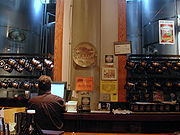
Filtered beer
Encyclopedia

Beer
Beer is the world's most widely consumed andprobably oldest alcoholic beverage; it is the third most popular drink overall, after water and tea. It is produced by the brewing and fermentation of sugars, mainly derived from malted cereal grains, most commonly malted barley and malted wheat...
in which yeast is no longer in suspension
Suspension (chemistry)
In chemistry, a suspension is a heterogeneous fluid containing solid particles that are sufficiently large for sedimentation. Usually they must be larger than 1 micrometer. The internal phase is dispersed throughout the external phase through mechanical agitation, with the use of certain...
. There are several methods used for clearing yeast from beer, from waiting for the yeast to drop of its own accord ("dropping bright") to filtering
Filtered beer
Bright beer is beer in which yeast is no longer in suspension. There are several methods used for clearing yeast from beer, from waiting for the yeast to drop of its own accord to filtering it.-Dropping bright:...
it.
Dropping bright
When the concentration of fermentable sugars in the beer falls below a certain level, variable with the strain of yeast, the yeast cells will naturally flocculateFlocculation
Flocculation, in the field of chemistry, is a process wherein colloids come out of suspension in the form of floc or flakes by the addition of a clarifying agent. The action differs from precipitation in that, prior to flocculation, colloids are merely suspended in a liquid and not actually...
and settle toward the bottom of the vessel in which the beer is stored; this act is known as dropping bright. The degree to which yeast flocculates is dependent on many factors, including the specific gravity
Specific gravity
Specific gravity is the ratio of the density of a substance to the density of a reference substance. Apparent specific gravity is the ratio of the weight of a volume of the substance to the weight of an equal volume of the reference substance. The reference substance is nearly always water for...
of the beer, the gas pressure over the beer, the ambient temperature, and some biological properties particular to the yeast strain; some beers will never drop bright by themselves.
Some breweries make available rack bright beer, which is cask-conditioned beer that has been dropped bright at the brewery and then racked, transferred, to a new container for shipment. Rack bright beer generally costs slightly more than ordinary beer, all else being equal, but requires less preparation time and care at the point of serving; in particular, dropping bright requires that the beer be left undisturbed to settle, as jarring or shaking its container will re-suspend the yeast.
Any beer which has been dropped bright or fined will have a layer of yeast sediment at the bottom of its storage vessel.
Fining
FiningsFinings
FiningsThe term is a mass noun rather than a plural. are substances that are usually added at or near the completion of the processing of brewing wine, beer and various nonalcoholic juice beverages. Their purpose is for removal of organic compounds; to either improve clarity or adjust flavor/aroma...
can be introduced during the production of beer in order to induce it to drop bright more readily. For British beers, the most common fining agent is isinglass
Isinglass
Isinglass is a substance obtained from the dried swim bladders of fish. It is a form of collagen used mainly for the clarification of wine and beer. It can also be cooked into a paste for specialized gluing purposes....
, and most breweries producing Real Ale introduce isinglass into the shipment cask so that the beer will drop bright readily upon the cask's being breached; this process can take from several hours to two or three days and may require the addition of supplementary finings by the cellarman.
Filtration
In contrast to dropping bright, yeast may also be removed from beer through filtration. The process of filtering removes carbonation and means the beerBeer
Beer is the world's most widely consumed andprobably oldest alcoholic beverage; it is the third most popular drink overall, after water and tea. It is produced by the brewing and fermentation of sugars, mainly derived from malted cereal grains, most commonly malted barley and malted wheat...
requires force carbonation. Mechanical filtering and even pasteurisation of bottled beer started at the end of the 19th century, though the first beer known to have been mechanically filtered and force carbonated as draught keg beer was Watneys Red Barrel in 1931.

